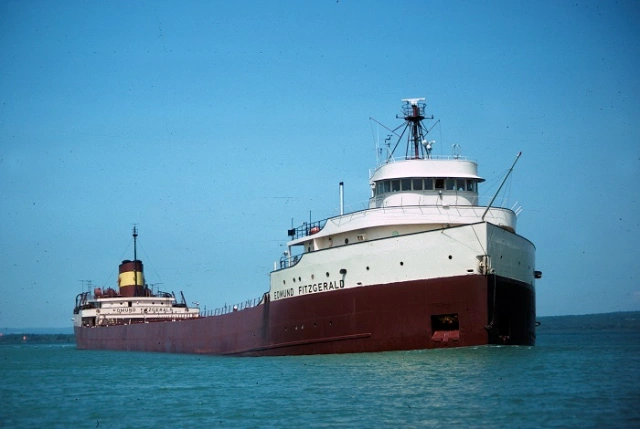Bestselling author visits Shorewood Library
courtesy Shipwatcher News Great Lakes Ships
Edmund Fitzerald on the St. Marys river, August 1975
Rochelle Pennington leads discussions about SS Edmund Fitzgerald
Many people are familiar with the Titanic, the doomed ocean liner whose fate was soon adapted into a major feature film starring a young Leonardo DiCaprio, but few are familiar with the “Titanic of the Great Lakes,” a macabre moniker given to the SS Edmund Fitzgerald.
In a program at the Shorewood Public Library on November 14, author and storyteller Rochelle Pennington discusses the numerous hypotheses and competing opinions of dive detectives still trying to uncover the mystery of what killed the 29-man crew aboard the ship.
Pennington is a bestselling author and award-winning newspaper columnist whose novels include Highlighted in Yellow, The Historic Christmas Tree Ship, and An Old-Fashioned Christmas. Her work has appeared in a number of bestselling series such as Chicken Soup for the Soul and Don’t Sweat the Small Stuff. Pennington has given over 2,000 talks in the last twenty years, inspiring over 25,000 people each year. She speaks at 150 events annually, the most recent of which covering “The Wreck of the SS Edmund Fitzgerald.”
Pennington began by giving an overview of the lake freighter, a 700-foot-long ship that cost more than $8,000,000—roughly $45,000,000 today. Over 10,000 people from all over the country, and even the world, gathered to witness the launch of the SS Edmund Fitzgerald, named after the American business executive and co-founder of the Milwaukee Brewers born and raised in Wisconsin, the largest ship ever built up to that point, and the largest sunken ship on the Great Lakes. Additionally, Pennington included some intriguing details about its tomb: Lake Superior, known as the “Greatest of the Great Lakes” due to it being largest, darkest, deepest, and cleanest.
Audience members were then led on a full circle tour of Lake Superior’s magnificent shoreline, complete with photographs and descriptions of islands, sand dunes, gold mines, historic lighthouses, cliffs, waterfalls, shipwrecks, logging camps and other “pinch-me” attractions Pennington has visited over the years. While her interest came as a result of her love for Lake Superior, Pennington was furthermore drawn to the story of the SS Edmund Fitzgerald because of its proximity to Wisconites and link to local history.
In discussing the many attributes of Lake Superior, Pennington shifted to the many current beliefs for the sinking of the SS Edmund Fitzgerald. One theory involved the wave movement on Lake Superior on the day it sank: November 10, 1975. It dealt with the phenomenon known as the “Three Sisters” — the formation of a series of three large waves, with the second wave striking the ship’s deck before the first, and the third incoming wave adding to the two accumulated backwashes and overloading the ship deck with tons of water — which was reported in the vicinity of the freighter.
Whether it was due to highly unpredictable and deadly waves, structural flaws, human error, the immense weight of its cargo, or that it ran aground on a shoal that damaged its hull, the reason for the SS Edmund Fitzgerald‘s sinking is unknown. Some believe the ship was doomed from the start, owing to the fact that its christening—smashing a bottle of champagne against the bow—took three full-throttle efforts, a bad omen, as a sailor would say. Furthermore, when the SS Edmund Fitzgerald took off, the way the water splashed into the spectator area, combined with the freezing temperatures, caused one man to have a heart attack: an omen of omens, if anything.
The mystery of the SS Edmund Fitzgerald compelled the audience to come up with their own solutions, and many of them voiced their opinions and questions following the event. Perhaps, as Pennington concludes, future technology and studies will determine an answer that will resolve the ambiguity of the Great Lakes’ deadliest incident. For the time being, we can let our imaginations run wild.

